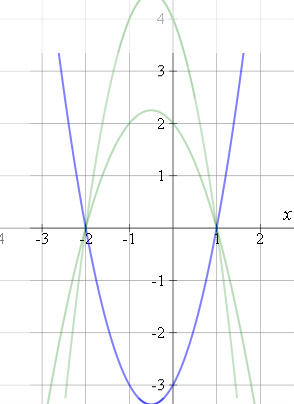Lesson 6: Determing a Quadratic Equation Given Its Roots
When given the roots, or the x-intercepts of a qaudratic equation, it is possible to determine the equation for the family of quadratic equations with those particular roots. A group of functions with the same roots is known as a family of quadratic equations. All the functions in a family have the same roots:
So how do we find the equation of a family given the roots. First, we take the roots and write the factors of the quadratic equation, in factored form . let`s look at an example:
Suppose the roots were x= 4 and x=2. We could calculate the factors very easily:
x=4 and x=2
x-4=0 and x-2=0
y=a(x-4)(x-2)
Therefore, the equation for this family of functions would be:
f(x): a(x-4)(x-2)
If given the roots of an equation and a point on the quadratic function, first find the family of the quadratic functions using the above method. Then substitute the point into the equation. This will allow you to find the value of a, which will allow you to compute the quadratic equation. Let`s look at an example:
Suppose our roots were x=2 and x=-3. A point on the quadratic equation is (0,3).
The factors would be x-2 and x+3. The family of the quadratic equations with roots x=2 and x=-3 are f(x)=a(x-2)(x+3).
Substitute the given point (0,3).
f(0)=3
3=a(0-2)(0+3)
3=-6a
a=-1/2
In standard form the equation is:
f(x)=(x-2)(x+3)
f(x)=-1/2(x²+x-6)
=-1/2x²-1/2x+3
With the above information, you will be able to solve many types of word problems.
Suppose the roots were x= 4 and x=2. We could calculate the factors very easily:
x=4 and x=2
x-4=0 and x-2=0
y=a(x-4)(x-2)
Therefore, the equation for this family of functions would be:
f(x): a(x-4)(x-2)
If given the roots of an equation and a point on the quadratic function, first find the family of the quadratic functions using the above method. Then substitute the point into the equation. This will allow you to find the value of a, which will allow you to compute the quadratic equation. Let`s look at an example:
Suppose our roots were x=2 and x=-3. A point on the quadratic equation is (0,3).
The factors would be x-2 and x+3. The family of the quadratic equations with roots x=2 and x=-3 are f(x)=a(x-2)(x+3).
Substitute the given point (0,3).
f(0)=3
3=a(0-2)(0+3)
3=-6a
a=-1/2
In standard form the equation is:
f(x)=(x-2)(x+3)
f(x)=-1/2(x²+x-6)
=-1/2x²-1/2x+3
With the above information, you will be able to solve many types of word problems.
© 2020 MyMathEducator.com All Rights Reserved.
